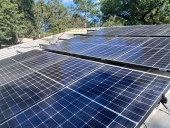

larry kidd wrote:It got down to about 20f last night and I never insulated or heated the batteries. Lost power about 2:30am took till about noon to get the cells warmed up to about 35f or 2c and got power back online. Spent the better part of the day after that wrapping the cells with heat tape for pipes and put insulation under and over , still need to go back and insulate the sides. Used 30 feet of heat tape with a 90w draw. It has it's own thermostat on at 35 off at 50 if I remember correctly.


Jackie Lei wrote:Yes, LiFePO₄ batteries really are a big step up. I’m also planning to upgrade, I’m looking at a 16 kWh LiFePO₄ battery for my home loads. The price is surprisingly low, just a little over $1,200. A friend recommended this battery manufacturer to me since I’m not very familiar with LiFePO₄ products myself.
This is the battery I’m considering. Could you help me take a look and let me know if the lifespan can really reach 10 years?


David Baillie wrote: Lithium is a game changer as well as you can get full array production since they have low resistance to charging unlike lead and you don't waste time at the high voltage low amperage low production absorb stage. It has forced solar designers to change their ways as we now maximize panel numbers due to low panel costs as our first priority. On the down side you are usually best to repanel completely so you can maximize your strings and the all in one inverters are terrible at lead acid charging as they lack a proper 3 stage charging profile.

John Carr wrote:
I should have mentioned that I'm in the northeast, only an hour and a half from the Canadian border. My water inlet pipe has to be down at about 5' to avoid freezing, so I'm hesitant to make an exterior housing, even if insulated. The water's coming in on the north side of the house so I have to battle the cold where it emerges from the trench.
I'm thinking of putting in a small 'basement' within the edge of the foundation (maybe 5'x5') that I can access through a trap door in the inside floor to turn off the water. But maybe this is not necessary? Otherwise I can just run it up from the trench through the soil, and maybe since it's within the perimeter of the foundation it's not in danger of freezing? I would just insulate the foot or so from the underside of the floor down a foot or two into the soil.

John Carr wrote:
how do I run the water inlet and septic outlet through the rubble trench foundation? Do I just put it among the rubble and hope it won't get crushed? Or do I need to build a small "basement" from concrete block or something to house the water inlet and outlet?
